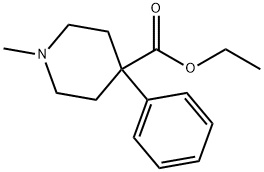페티딘
|
|
페티딘 속성
- 녹는점
- 270°C
- 끓는 점
- 390.37°C (rough estimate)
- 밀도
- 1.0267 (rough estimate)
- 굴절률
- 1.5130 (estimate)
- 인화점
- 11 °C
- 저장 조건
- −20°C
- 산도 계수 (pKa)
- pKa 8.7 (Uncertain)
- 수용성
- 6.55g/L(25℃)
- BCS Class
- 1
안전
- 위험 및 안전 성명
- 위험 및 사전주의 사항 (GHS)
| 위험품 표기 | F,T | ||
|---|---|---|---|
| 위험 카페고리 넘버 | 11-23/24/25-39/23/24/25 | ||
| 안전지침서 | 7-16-36/37-45 | ||
| 유엔번호(UN No.) | UN 1230 3/PG 2 | ||
| WGK 독일 | 1 | ||
| 유해 물질 데이터 | 57-42-1(Hazardous Substances Data) | ||
| 독성 | A narcotic analgesic used for moderate to severe pain and during obstetrical anesthesia. Its oral LD50 in rats is 170 mg/kg. It has multiple actions qualitatively similar to those of morphine, and therapy is similar to that for morphine. Advantages over morphine concerning efficacy and reduced risk of addiction were largely illusory. This, and potential drug interactions, have resulted in a dramatic reduction in use. |
| 그림문자(GHS): |
  
|
|||||||||||||||||||||
|---|---|---|---|---|---|---|---|---|---|---|---|---|---|---|---|---|---|---|---|---|---|---|
| 신호 어: | Danger | |||||||||||||||||||||
| 유해·위험 문구: |
|
|||||||||||||||||||||
| 예방조치문구: |
|
페티딘 C화학적 특성, 용도, 생산
용도
Analgesic (narcotic).Biological Functions
Meperidine (Demerol) is a phenylpiperidine derivative of morphine that was developed in the late 1930s as a potential anticholinergic agent. It has some anticholinergic side effects that lead to tachycardia, blurred vision, and dry mouth. Meperidine is approximately onefifth as potent as morphine and is absorbed only half as well when administered orally as parenterally. It has a rapid onset and short duration of action (2 hours), that is, approximately one-fourth that of morphine.Like morphine, meperidine has an active metabolite, normeperidine, formed by N-demethylation of meperidine. Normeperidine is not analgesic but is a proconvulsant and a hallucinogenic agent. For this reason, meperidine use in patients with renal or liver insufficiency is contraindicated because of the decreased clearance of the drug and its metabolite. Convulsant activity has been documented in elderly patients given meperidine and in patients using PCA who have decreased renal function.
Meperidine differs from morphine in that it has far less antitussive effect and little constipative effect. The drug is particularly useful in cancer patients and in pulmonary patients, in whom the cough reflex must remain intact. However, it does have more seizure-inducing activity than morphine. Although meperidine produces spasms of the biliary tract and colon, such spasms are of shorter duration than those produced by morphine.
Meperidine readily passes the placenta into the fetus. However, respiratory depression in the newborn has not been observed, and meperidine clearance in the newborn is rapid in that it does not rely upon conjugation to glucuronides. Meperidine, unlike morphine, has not been associated with prolongation of labor; conversely, it increases uterine contractions.
일반 설명
Meperidine (Demerol) was discovered in 1939 during a serendipitous screening of compounds being studied for antispasmodic activity. Mice given meperidine were noted to carry their tails in an erect position (the Straub tail reaction), which was indicative of narcotic analgesia. This led to the study of meperidine and derivatives as analgesic agents. Meperidine was found to have low potency at the receptor compared with morphine (0.2%) but much higher penetration into the brain resulting in a compound with about 10% of the potency of morphine.Structural changes that increase the potency of meperidine include the introduction of an mhydroxyl on the phenyl ring, substituting the methyl on the N for a phenylethyl or a p-aminophenylethyl. Replacing the N-methyl with an N-allyl or N-cyclopropylmethyl group does not generate an antagonist, unlike the similar substitution of the morphine congeners. Meperidine quickly penetrates the blood-brain barrier and thus has a quick onset of activity and a high abuse potential.
주의 사항
Contraindications are similar to those of morphine. In addition, because normeperidine accumulates in renal dysfunction and meperidine accumulates in hepatic dysfunction, meperidine is contraindicated in such patients because of convulsant effects. Similarly, the use of meperidine is contraindicated in patients who have a history of seizures or who are taking medication to prevent seizures. Phenytoin administered for seizures may reduce the effectiveness of meperidine by increasing the metabolism of the drug in the liver. Meperidine is not generally used in patients with cardiac dysfunction, since its anticholinergic effects can increase both heart rate and ectopic beats.페티딘 준비 용품 및 원자재
원자재
준비 용품
페티딘 관련 검색:
메페리딘 수화염화물
MEPERIDINE
hydroxypethidine
DIPHENOXYLATE HYDROCHLORIDE
Piminodine
morpheridine
Diphenoxylate
phenoperidine
Benzethidine
furethidine
etoxeridine
properidine
Anileridine
MEPERIDINE (D4),Meperidine-(piperidine-3,3,5,5-d4) solution,Meperidine-d4 solution
Meperidine acid
Carperidine
Oxpheneridine
Butoxylate






